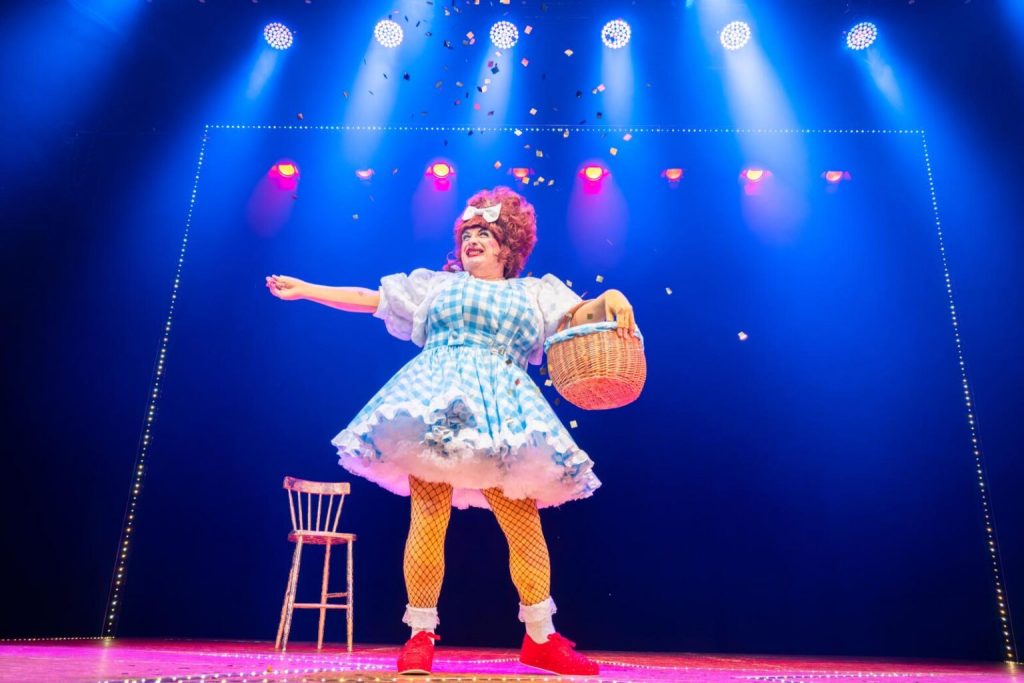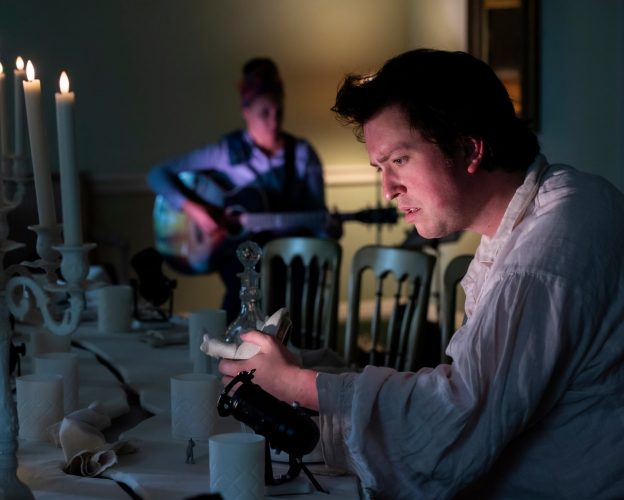Three different true-life stories, three very different styles of storytelling, as witnessed by Dorothy Max Prior at the Edinburgh Festival Fringe 2025
Shows in storytelling mode are very much a thing at the Edinburgh Festival Fringe, which is awash with one-person performances of one sort or another. Here, I’m sticking to three shows that tell true-life stories – albeit with very different subjects, and told in very different ways.
First up, Victory Melody with Trouble, Struggle, Bubble and Squeak, which has been directed by Mark Thomas. Victoria’s modus operandi is to immerse herself fully in something or-other – in the past, it’s been pigeon-fanciers, beauty pageants, Cruft’s dog show, funeral directors, wig-makers, stand-up comedians and maybe others I’ve forgotten – and after a long phase of deep research to then create installations or theatre pieces that result from that research. But it’s crucial to note that she doesn’t just observe the thing – she gets in there and does it. The resulting shows are always a charming mix of investigation into the subject at hand and autobiographical confession.
When she got divorced, she tells us, she Googled ‘the world turned upside down’ expecting a bit of cosy self-help advice. Instead, her search brought up the Christopher Hill book of the same name, and she found herself immersed in the 17th century world of radical movements such as The Levellers and The Diggers. From here – with perfect Vic logic – this led to her joining an English Civil War re-enactment society, finding herself kitted out in an authentic red wool suit and shoes that have neither a right nor a left foot, but point straight ahead. Perfect for my long toes, says Vic. She then twigged that she’d accidentally joined the wrong side, becoming a Royalist rather than a Roundhead. Never mind!
Settling in to her research, The Diggers become the anti-Royalist movement she most admires – thus called because of their insistence on the right to farm on common land. Trouble, Struggle, Bubble and Squeak takes us on a dizzying journey that draws parallels between the Diggers and contemporary land protectors, ecologists, and food bank heroes; and relays how she became involved in a community centre called The Crew on a deprived council estate in Whitehawk, in which she joined forces with the locals in turning a neglected area overgrown with brambles in to a community vegetable garden.
Victoria is performing alone – although she has a set of life-sized cardboard cut-outs of her heroes with her to keep her company. There’s Diggers co-founder Gerrard Winstanley (whose mantra was ‘the earth is a shared treasure’); Brighton local legend Dave (a naturalist, not a naturist – Vic says she keeps getting it wrong) who has discovered a new type of insect, the soldier beetle, on Whitehawk Hill; Brian who runs the food bank and manages to access £50,000 worth of cheese to distribute; and Lacey, the lady who runs the Crew Club, and welcomes Vic into the fold. When Vic first moots the idea of the locals playing the Diggers in a re-enactment battle with the Royalists, they are at first sceptical but eventually rally round, and a great time is had by all – including the off-piste battle victory for the Diggers (‘Er, this isn’t historically correct,’ says one of the re-enactment chaps – but never mind, it happens!) – plus, the consumption of vast vats of genuine-recipe 17th century stew. And unlike those busy-bodies from arts orgs who descend on Whitehawk with their ‘pushy, unwanted origami’, Vic is in it for long haul. The current phase of her project ends with Brighton Council turning a blind eye to the JCB used illegally to dig up the brambles, and grants them a 25-year lease on the new community garden… Another victory for our Vic. Who knows who she’ll next embrace!
A very lovely show, full of tenderness, feisty political suss, and fabulous comic moments.

Also based on historical data comes The Burns Project, in which writer and actor James Clements gives us the story of Scotland’s national poet Robert Burns, a production directed by Cora Bissett that uses Burns’ private letters, papers and other recently-archived documents as its source material.
The piece is set in a room in The Georgian House, a Robert Adam-designed townhouse run by the National Trust for Scotland. One of the bonuses of going to see the show is the chance to look round this grand house if you arrive early, which is a fabulous treat. When it is time, a group of twenty of us are led upstairs and seated around a table. We are told not to touch anything! All is a creamy white: the calico-covered tabletop, which has a winding gash carved in to it; the platters and goblets; the cutlery and condiments; the ornaments, which include farm animals, trinket boxes and flowers.
At one end of the room, a musician sits – this is Lisa Rigby, who gives us re-workings of Burns’ songs on acoustic guitar and a beautiful drone-y shruti box. James Clements, in character as Robert Burns, bright eyed and bushy tailed, enters at the other end of the room, and we’re away.
The following hour is a clever mix of fictional first-person storytelling – ‘Rabbie’ charming us with his own version of his life – interspersed with contemporary commentary delivered through hidden speakers on the table that give us short reflections on the man and his life; and the additionally live commentary through song delivered by the musician. Then, there’s
the fabulous visual storytelling enacted through that long table (designed by Jenny Booth) and those various objects: The gash in the table is lit up with red light as lightning strikes, and with blue as a tiny ship sails along it, on its way to the West Indies. Rabbie’s head appears on a platter, full of remorse, appealing for understanding. The tiny animals tell the tale of the farmer’s son turned poet. Cruets or tiny boxes reveal rings and coins that play a part in the story.
Clements as Burns weaves around the audience, serenading and appealing for love and appreciation – mostly targeting the women in the audience. He holds hands, locks eyes, passes tiny notes, and smiles that beguiling smile. It is very easy to believe that here is Burns, brought back to life to delight and charm us.
But it’s not all red, red roses – the production doesn’t pass over the difficult aspects of Burns’ biography. There’s the maid he impregnates as a teenager and is not permitted to marry, and later (almost as a counterpoint) the pregnant lover he abandons. There’s the relationship with Jean Amour, who he at first is not permitted to marry, but eventually does. There’s the fact that it was only the unexpected success of the publication of his early writings that stopped him sailing off on that boat to Jamaica to work for the enslavers. There’s the babies who die. The farms that he struggles to keep. And the odd fact that, when his early publishing success peters out, this unconventional Socialist and anti-establishment hero becomes a tax collector in order to pay his bills and keep his family afloat!
A complicated man, who did so much in a short lifetime – poet, songwriter, collector and cataloguer of Scottish folk songs, farmer, family man and more. It is astonishing to think that that he died at just 37 years of age.
As we are told early in the production, apart from ‘Happy Birthday’, Burns’ ‘Auld Lang Syne’ is probably the most sung song in the world, compulsory on New Year’s Eve right across the world. ‘Should auld acquaintance be forgot, and never brought to mind?’ No, no – never. ‘We’ll tak’ a cup o’ kindness yet, for auld lang syne.’ Good to make your acquaintance, Rabbie! I won’t forget you… and I still have my secret letter from you.

Another Scottish production, and more storytelling, this time a bona fide one-man show, although he stands on the shoulders of giants. Or maybe that’s giantesses. For it is Johnny McKnight aka Widow McTwanky – Scotland’s most famous Pantomime Dame. The lights are flashing, the entrance music blasting out, but where is she? She’s behind you! No, really she is – entering from the back of the auditorium in a blue gingham dress, fright-wig and a ‘hideous yet age-appropriate leisure shoe’ – comfy, but red and sparkly, of course. This particular McKnight alter-ego is Dorothy Blawna-Gale – fresh from the Land of Oz. There follows a thrilling hour’s worth of caustic humour, sizzling storytelling, song, dance, and audience participation – which ranges from the gentle engagement of catching packets of sweeties thrown out to the crowd, to the snogging of a gentleman called Alan (‘They’re always called Alan’), and the invitation given to a young woman volunteering to come up on stage and be a Silly Billy – the red-rouged, gormless character usually played by the youngest male member of the company. And yes, we learn, this is how Johnny started out: as a Silly Billy. Later, these interactions all becomes material for reflections on safeguarding, consent and onstage representation.
All the interactive fun and games was to be expected – but there’s also a good dose of pantomime history woven into the evening; plus a poignant coming out story, documenting Johnny’s personal journey as a young gay man from Silly Billy to Dame, in the surprisingly heterosexual world of traditional Panto; and concurrently the story of Scottish Panto’s evolution from tabloid-pandering racial caricatures and dodgy jokes to something (under McKnight’s watch as writer, director and performer) far more inclusive and diversified.
With a costume change from Dorothy’s gingham to fabulous flouncy swan feathers, we get the culmination of the story of Panto’s first full-blown gay kiss, in a reworked version of Jack and the Beanstalk premiered (successfully!) to an audience of infant school children and a Christian bible group.. This is all both jolly good fun, and proper edu-tainment.
Johnny McKnight is a legend in Scotland –and it is great to see She’s Behind You – presented at the Traverse, and directed by John Tiffany – becoming such a big hit of the Edinburgh Fringe 2025.
Featured image (top) James Clements: The Burns Project
Victoria Melody: Trouble, Struggle, Bubble and Squeak, Pleasance Courtyard, 14:15
James Clements: The Burns Project, The Georgian House, 18:30 (until 16 August)
Johnny McKnight: She’s Behind You, Traverse Theatre, 21.15 or 21.30
For further information or to book tickets see www.edfringe.co.uk

